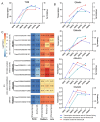Preferentially expressed endosperm genes reveal unique activities in wheat endosperm during grain filling
- PMID: 39174916
- PMCID: PMC11340063
- DOI: 10.1186/s12864-024-10713-4
Preferentially expressed endosperm genes reveal unique activities in wheat endosperm during grain filling
Abstract
Background: Bread wheat (Triticum aestivum L.) endosperm contains starch and proteins, which determine the final yield, quality, and nutritional value of wheat grain. The preferentially expressed endosperm genes can precisely provide targets in the endosperm for improving wheat grain quality and nutrition using modern bioengineering technologies. However, the genes specifically expressed in developing endosperms remain largely unknown.
Results: In this study, 315 preferentially expressed endosperm genes (PEEGs) in the spring wheat landrace, Chinese Spring, were screened using data obtained from an open bioinformatics database, which reveals a unique grain reserve deposition process and special signal transduction in a developing wheat endosperm. Furthermore, transcription and accumulation of storage proteins in the wheat cultivar, XC26 were evaluated. The results revealed that 315 PEEG plays a critical role in storage protein fragment deposition and is a potential candidate for modifying grain quality and nutrition.
Conclusion: These results provide new insights into endosperm development and candidate genes and promoters for improving wheat grain quality through genetic engineering and plant breeding techniques.
Keywords: Developmental transcription; Endosperm; Storage protein; Wheat.
© 2024. The Author(s).
Conflict of interest statement
The authors declare no competing interests.
Figures





Similar articles
-
TaWUS-like-5D affects grain weight and filling by inhibiting the expression of sucrose and trehalose metabolism-related genes in wheat grain endosperm.Plant Biotechnol J. 2025 Jun;23(6):2018-2033. doi: 10.1111/pbi.70015. Epub 2025 Mar 6. Plant Biotechnol J. 2025. PMID: 40048350 Free PMC article.
-
Comprehensive analysis of the transcription of starch synthesis genes and the transcription factor RSR1 in wheat (Triticum aestivum) endosperm.Genome. 2013 Feb;56(2):115-22. doi: 10.1139/gen-2012-0146. Epub 2012 Dec 14. Genome. 2013. PMID: 23517321
-
iTRAQ-based quantitative proteome and phosphoprotein characterization reveals the central metabolism changes involved in wheat grain development.BMC Genomics. 2014 Nov 27;15(1):1029. doi: 10.1186/1471-2164-15-1029. BMC Genomics. 2014. PMID: 25427527 Free PMC article.
-
An Overview of Factors Affecting the Functional Quality of Common Wheat (Triticum aestivum L.).Int J Mol Sci. 2023 Apr 19;24(8):7524. doi: 10.3390/ijms24087524. Int J Mol Sci. 2023. PMID: 37108683 Free PMC article. Review.
-
Understanding the regulation of cereal grain filling: The way forward.J Integr Plant Biol. 2023 Feb;65(2):526-547. doi: 10.1111/jipb.13456. J Integr Plant Biol. 2023. PMID: 36648157 Review.
References
-
- Malik AH, Kuktaite R, Johansson E. Combined effect of genetic and environmental factors on the accumulation of proteins in the wheat grain and their relationship to bread-making quality. J Cereal Sci. 2013;2:170–4.10.1016/j.jcs.2012.09.017 - DOI
MeSH terms
Substances
Grants and funding
- xjnkq-2022006/Xinjiang Academy of Agricultural Sciences young science and technology backbone innovation ability training project
- xjnkq-2022006/Xinjiang Academy of Agricultural Sciences young science and technology backbone innovation ability training project
- xjnkq-2022006/Xinjiang Academy of Agricultural Sciences young science and technology backbone innovation ability training project
- xjnkq-2022006/Xinjiang Academy of Agricultural Sciences young science and technology backbone innovation ability training project
- XJARS-01/Xinjiang Agriculture Research System
- XJARS-01/Xinjiang Agriculture Research System
- XJARS-01/Xinjiang Agriculture Research System
- XJARS-01/Xinjiang Agriculture Research System
- XJARS-01/Xinjiang Agriculture Research System
- XJARS-01/Xinjiang Agriculture Research System
- XJARS-01/Xinjiang Agriculture Research System
- XJARS-01/Xinjiang Agriculture Research System
- 2023LQJ04/"Two Zones" Science and Technology Development Project
- 2023LQJ04/"Two Zones" Science and Technology Development Project
- 2023LQJ04/"Two Zones" Science and Technology Development Project
- 2022LQ03017/Silk Road Economic Belt Innovation-driven Development Pilot Zone, Wuchangshi National Independent Innovation Demonstration Zone Science and Technology Development Plan
- 2022LQ03017/Silk Road Economic Belt Innovation-driven Development Pilot Zone, Wuchangshi National Independent Innovation Demonstration Zone Science and Technology Development Plan
- 2022LQ03017/Silk Road Economic Belt Innovation-driven Development Pilot Zone, Wuchangshi National Independent Innovation Demonstration Zone Science and Technology Development Plan
- 2022LQ03017/Silk Road Economic Belt Innovation-driven Development Pilot Zone, Wuchangshi National Independent Innovation Demonstration Zone Science and Technology Development Plan
LinkOut - more resources
Full Text Sources

